SSZT524 march 2019 AFE7422 , AFE7444
Frequency hopping describes a method in which communication systems rapidly change their operating frequency for purposes specific to their application. Applications such as communications, radar and electronic warfare use frequency hopping in order to avoid interference or detection, or to detect cloaked signals. The faster these systems can change frequencies – or frequency hop – the more agile they become, making it easier to avoid interference and detection.
Traditional frequency hopping uses an analog mixer and a phase-locked loop/voltage-controlled oscillator, and changing frequencies can take quite a long time. As radio-frequency (RF) sampling has become more prevalent, frequency hopping has moved toward a numerically controlled oscillator (NCO)-based hopping technique; however, the frequency hop time can still be limited by a slow Serial Peripheral Interface (SPI) and the multiple register writes required to update the NCO. Figure 1 shows a typical complex digital mixer with a single NCO.
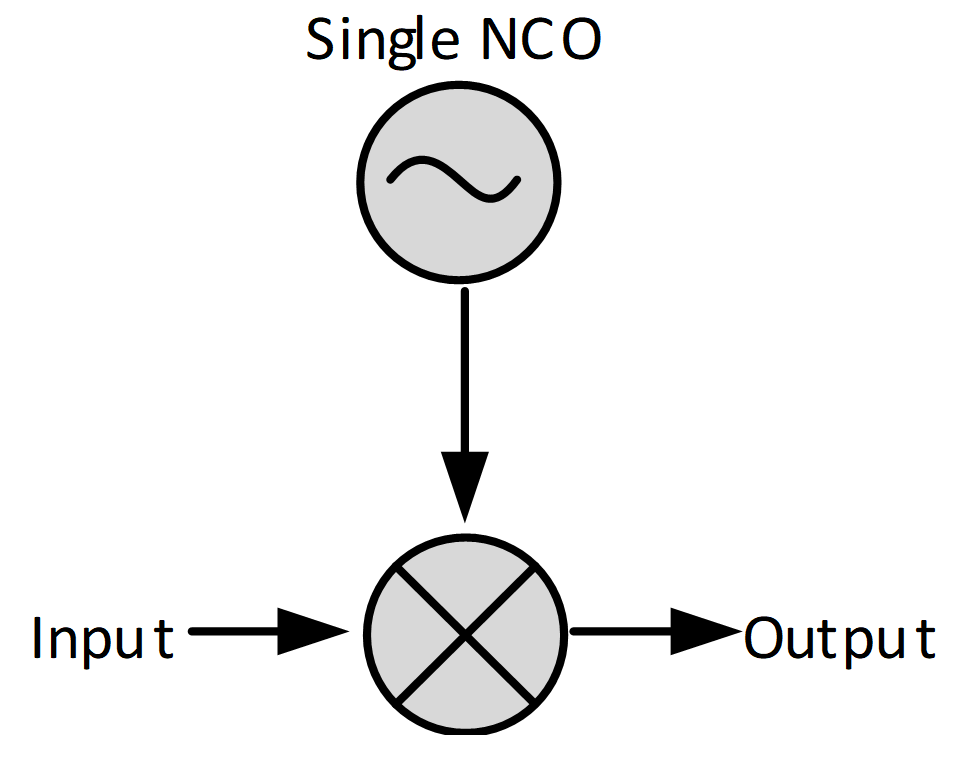 Figure 1 Complex Mixer with a Single
NCO
Figure 1 Complex Mixer with a Single
NCOIn this blog post, I’ll introduce a technique that enables faster frequency hopping using an architecture with multiple NCOs.
| Design for faster frequency hopping | |

|
Learn more about the frequency hopping capability of the AFE7444 and AFE7422 in our application note. |
First, let’s look at how long it takes to update the frequency with a single NCO. Figure 2 shows the time it takes to reprogram transmitter (Tx) NCO0 from 10 MHz to 100 MHz. The yellow signal shows DAC A in direct digital synthesis (DDS) mode, where the frequency of the signal is the active NCO frequency. Each falling edge in the blue signal represents the start of a single SPI write. Updating the transmitter NCO frequency requires seven SPI writes. As you can see, updating the frequency of Tx NCO0 from 10 MHz to 100 MHz takes about 4.6 µs, with a maximum SPI clock of 40 MHz.
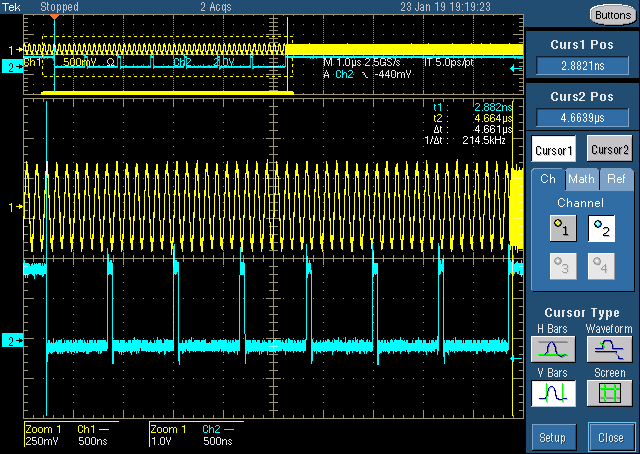 Figure 2 Updating the Frequency in One
NCO Takes about 4.6 Μs
Figure 2 Updating the Frequency in One
NCO Takes about 4.6 ΜsIt is possible to achieve faster frequency hopping with multiple frequency-flexible NCOs, as opposed to reprogramming one NCO. When multiple NCOs are available, you can program the NCOs that are not selected to different frequencies in the background via SPI while the currently selected NCO is active. When it’s time to change frequencies, you only need to change the selected NCO.
Figure 3 gives an example of this method using TI’s AFE7422. In the AFE7422, each receiver (Rx) contains four available NCOs in dual-band mode and three available NCOs in single-band mode. Rx NCO0 and Rx NCO1 are loading the center frequencies of the blue and red bands in the input spectrum, respectively, while Rx NCO2 is currently selected to downconvert the green band in the input spectrum. Hopping to a different-colored band only requires sending a command to select an already-programmed NCO to the desired band’s frequency, greatly reducing hop time.
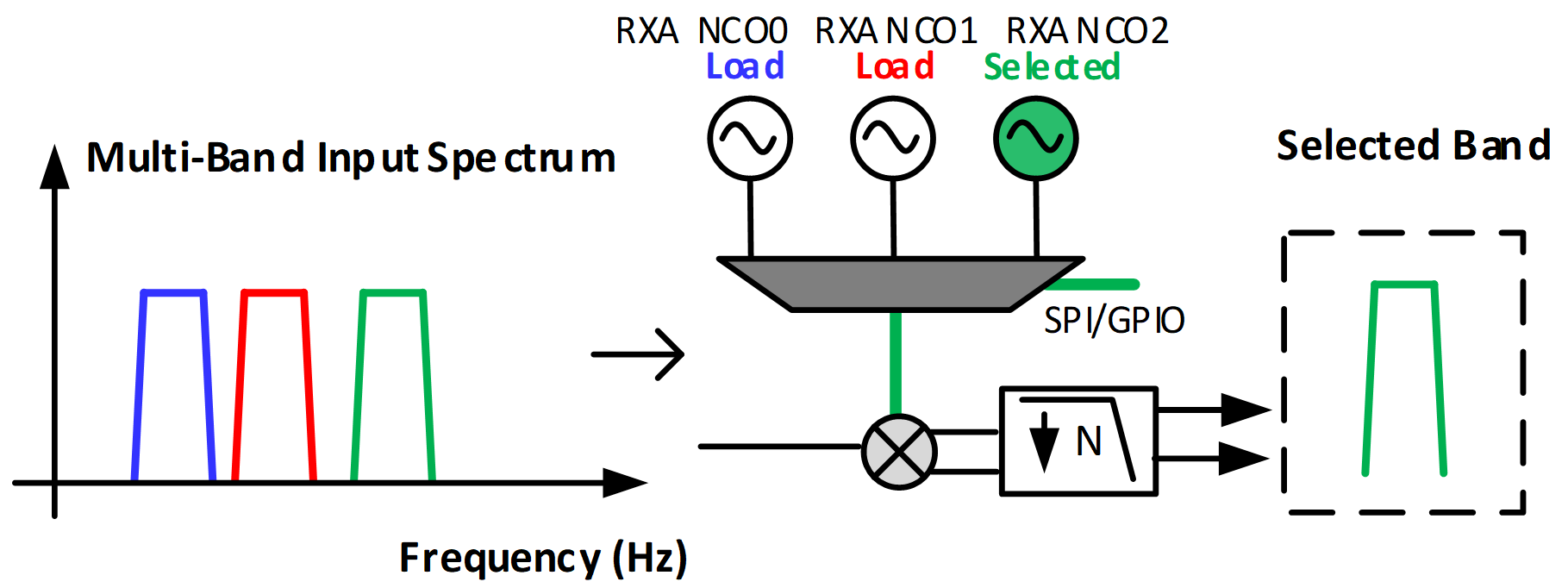 Figure 3 Example of Frequency Hopping
with Multiple NCOs
Figure 3 Example of Frequency Hopping
with Multiple NCOsIt takes much less time to change NCOs than it does to reprogram a single NCO.
Figure 4 shows the time it takes to switch from Tx NCO0, programmed to 10- MHz, to Tx NCO1, which is also programmed to 10 MHz. The yellow signal shows DAC A in DDS mode, where the frequency of the signal is the active NCO frequency. Each falling edge in the blue signal represents the start of a single SPI write sent to the device. One SPI write is required to switch NCOs, reducing the hop time from 4.6 µs to approximately 660 ns.
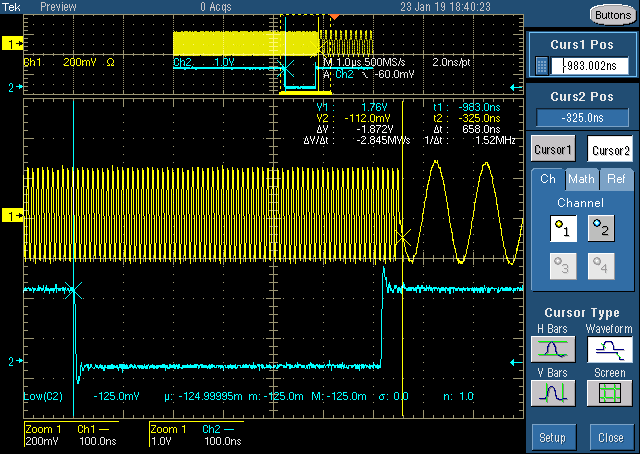 Figure 4 The Hop Time When Switching
from One NCO to Another Is Approximately 660 Ns
Figure 4 The Hop Time When Switching
from One NCO to Another Is Approximately 660 NsIn the AFE7444 and AFE7422 receivers, it’s possible to switch NCOs using a general-purpose input/output (GPIO), which takes even less time. While switching NCOs via SPI takes about 660 ns, Figure 5 shows the time it takes to switch from an Rx NCO programmed to 100 MHz to an NCO programmed to 10 MHz using a GPIO. At time t = 0, the GPIO pin is triggered to switch NCOs; as you can see, it takes less than 300 ns to switch from one NCO to another.
 Figure 5 Rx NCO Switching via GPIO; at
Time T = 0, GPIO Is Triggered, and the Hop Time Is about 300 Ns
Figure 5 Rx NCO Switching via GPIO; at
Time T = 0, GPIO Is Triggered, and the Hop Time Is about 300 NsMore NCOs available in a frequency-hopping system enables more selectivity when executing fast frequency hopping. The receiver digital downconverter (DDC) multiplexer is an optional feature available on the AFE7444 that uses the fast-frequency-hopping technique for multiband selectivity. Figure 6 illustrates how the DDC multiplexer feature works.
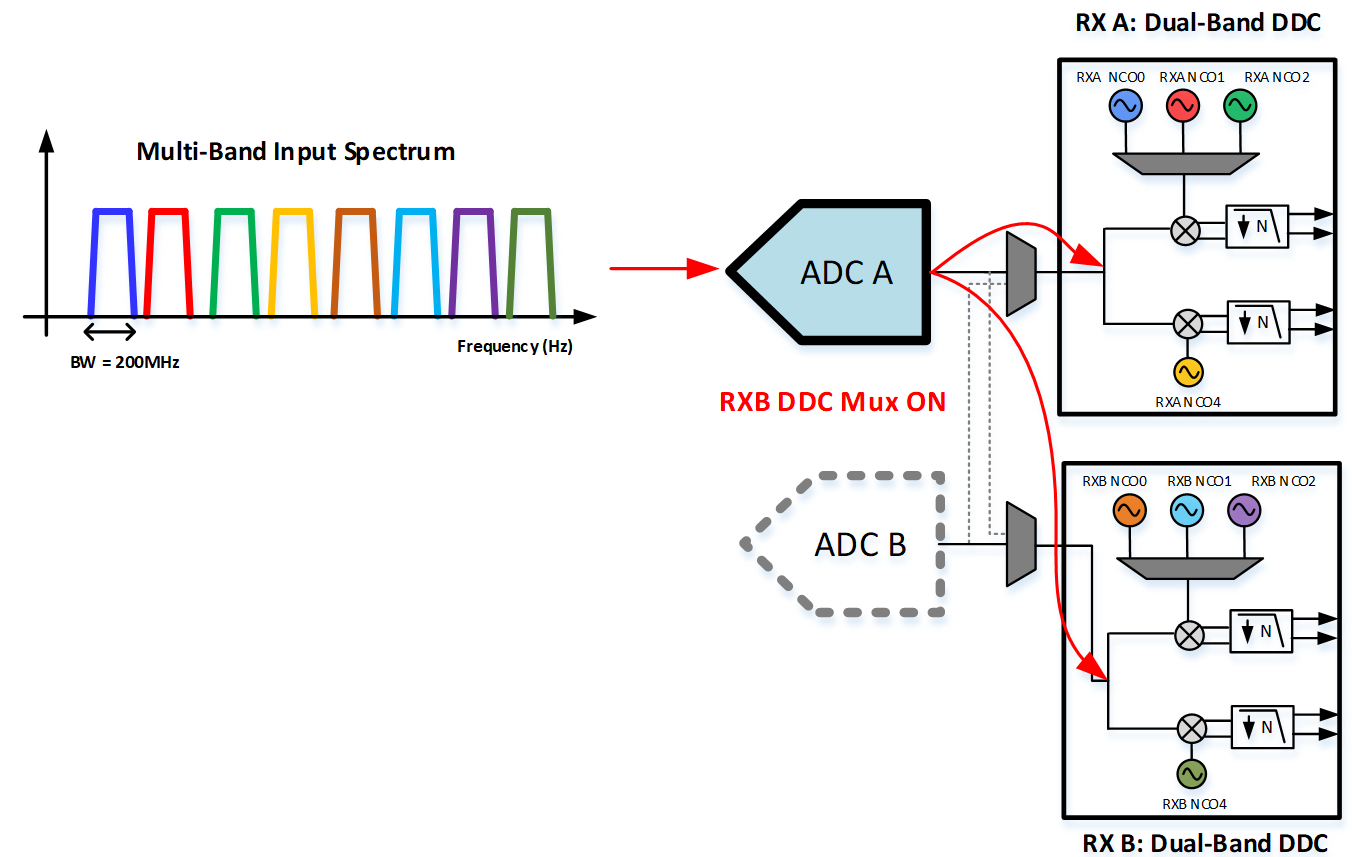 Figure 6 DDC Multiplexer Feature
Illustration
Figure 6 DDC Multiplexer Feature
IllustrationWith the receiver DDC multiplexer feature enabled, a single analog-to-digital converter (ADC) with an instantaneous bandwidth of 1,200 MHz digitizes an analog input spectrum and outputs the digital data to both of the multi-DDC blocks within the same Rx pair. (ADC A and B represent the first receiver pair and ADC C and D represent the second receiver pair). Turning off the unused ADC in the pair can save power. Using this feature in dual-DDC mode, where both DDCs are active in each ADC, shows just how selective the AFE7444 and AFE7422 receivers can be when frequency hopping.
The AFE7444 is configured in dual-band mode, where each ADC can selectively send two bands at a time to a digital processor. ADC A samples the entire input spectrum containing the multicolored, 200-MHz-wide bands. The digitized spectrum at the output of ADC A is then routed to the multi-DDC input of both ADC A and ADC B, while ADC B is turned off to save power. Each receiver NCO within each multi-DDC mixer is then programmed to the center frequency of a distinct band within the spectrum. The color of each receiver NCO identifies which band will be selected within the input spectrum. In total, each ADC pair within the AFE7444 or AFE7422 can pass up to four bands (out of eight bands) without updating the receiver NCO frequency.
If you’re ready for fast frequency hopping, check out the AFE7444 and AFE7422. These quad- and dual-channel RF-sampling transceivers enable the direct sampling of input frequencies into the C band without the need for additional frequency-conversion stages.